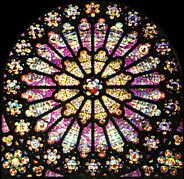 Rose window at Abbey of Saint-Denis |
|
||
Stained glass is a term used to describe windows composed of colored glass set in designs. In the West the earliest stained glass dates from the 11th century, but the finest stained-glass windows were produced in conjunction with Gothic art and architecture from about 1130 to 1330. In Islamic countries colored glass, set in wooden or stucco frames in foliate designs, is known to have been used beginning in the 12th century.
The earliest surviving Western examples are five windows (early 12th century) depicting Old Testament prophets in Augsburg Cathedral, Germany. Extensive use of stained glass, however, first occurred in Abbot Suger's rebuilding (1137-44) of the Royal Abbey of Saint-Denis near Paris, which provided enormous new windows, particularly in the ambulatory. These windows (now destroyed or heavily restored), were the direct inspiration for the three great lancet windows (c.1150) in the west facade of Chartres Cathedral, noted for the famed Chartres blue. They survived the disastrous fire of 1194 and were incorporated in the magnificent new cathedral begun in the same year. Most of the 173 huge windows produced in the next 30 years for Chartres Cathedral remain intact; the church's pictorial program was followed in the windows of Gothic cathedrals and churches throughout France and England. The Sainte-Chapelle in Paris, built 1243-48, contains 15 enormous windows with 1,134 narrative scenes that form walls of glass and mark the apogee of Gothic stained glass.
Gothic stained glass owes much of its beauty to the deliberately flat, two-dimensional design perfectly suited to the medium. By the late 14th century, perspective had been introduced in stained-glass design in imitation of painting, which led to a debasement of the art that reached its lowest point in the 18th century. The 19th-century Gothic Revival in architecture led to a rebirth of stained glass for both religious and secular buildings. William Morris and Sir Edward Burne-Jones spurred the revival in England, which then spread to the United States, where its most successful practitioners were John La Farge and Louis Comfort Tiffany.
|
||
A resurgence of the art and a return to two-dimensional design and the use of pure color occurred following World War II. The abstract secular designs of the German Ludwig Schaffrath and the windows by Henri Matisse for the Dominican Chapel of the Rosary (1951) in Vence, France, are the most notable works of modern times. In the United States two remarkable churches have employed stained glass on a large scale: Wallace K. Harrison's First Presbyterian Church (1959) in Stamford, Conn., has stained-glass walls and ceilings supported by concrete ribs; Skidmore, Owings, and Merrill's Air Force Academy Chapel, Colorado Springs, Colo. (1959), is almost entirely of stained glass suspended in aluminum frames, recalling Sainte-Chapelle's walls of glass.
Stained-glass technique has changed little since its development in the 11th century. Pieces of glass of various colors are placed together on a full-size model or drawing of the window. They are joined with lead strips that are soldered in place. The assembled panels are then suspended in the window frame or the stone tracery on iron bars called armatures; these were straight in 12th-century windows, but by the early 13th century they were shaped into circles, lozenges, quatrefoils, and combinations of these.
The colors were achieved by mixing metal oxides with the molten glass during smelting; the Chartres blue was obtained from cobalt mined in Bohemia; the mines were exhausted by the 14th century, and this azure blue could not be reproduced until the 20th century. Red was obtained from oxidized copper, green from bioxide of copper, purple from manganese mixed with cobalt, and yellow from manganese and ferrous oxide. Facial features, decorations, and lettering were painted in grisaille, a gray-brown enamel baked on the glass.
The glass was formed either in cylinders that were split and flattened, called muff glass, or spun centrifugally into a disk thicker in the center than at the rim, called crown glass. Bubbles, flaws, and other irregularities diffuse the light and make the glass sparkle. Stained glass, once believed to be impervious to the effects of time, has proved fatally susceptible to air pollution; this vulnerability has spurred conservation efforts throughout the Western world.